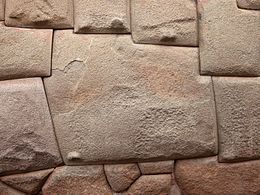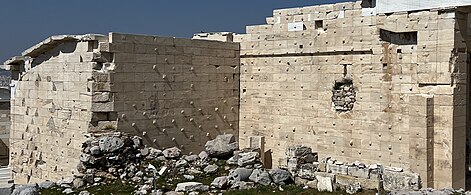Lifting boss
Knob left on stones by masons for levering or lifting
Lifting bosses or handling bosses are protrusions intentionally left on stones by masons to facilitate maneuvering the blocks with ropes and levers.[1][2]
They are an important feature of ancient and classical construction, and were often not cut away, despite having fulfilled their purpose. Sometimes this was the result of a cost-saving measure or a construction halt. Other times bosses were left as a stylistic element, and even if dressed back, a remnant of them was kept to make their existence obvious.[3]
- Lifting bosses of the crepidoma (base) of the Segesta temple, Sicily
-
 Levering bosses left on Inca walls of Cusco, Peru
Levering bosses left on Inca walls of Cusco, Peru -
 Bosses on the Propylaia (Acropolis of Athens)
Bosses on the Propylaia (Acropolis of Athens)
See also

Wikimedia Commons has media related to Lifting bosses.
- Boss (architecture)
- Bossage
References
- ^ Arnold, Dieter (1991). "Bosses". Building in Egypt: Pharaonic Stone Masonry. pp. 132–141. ISBN 9780195113747.
- ^ Stocks, Denys A. (2003). Experiments in Egyptian archaeology - Stoneworking technology in Ancient Egypt. p. 193.
- ^ Devolder, Maud; Kreimerman, Igor (2020). Ashlar: Exploring the Materiality of Cut-Stone Masonry in the Eastern Mediterranean Bronze Age. p. 313. ISBN 9782875589644.
Further reading
- Clarke, Somers; Engelbach, R. (1990). "Handling the Blocks". Ancient Egyptian construction and architecture. pp. 84–95. ISBN 978-0-486-26485-1.
- Coulton, J. J. (1974). "Lifting in Early Greek Architecture" (PDF). The Journal of Hellenic Studies. 94: 1–19. doi:10.2307/630416. JSTOR 630416.
- Philokyprou, Maria (2011). "The initial appearance of ashlar stone in Cyprus. Issues of provenance and use" (PDF). Mediterranean Archaeology and Archaeometry. 2011 (2, pp): 44–45. Archived from the original (PDF) on 2018-04-09.
- Schreiber, Th (1895). Anderson, W. C. F. (ed.). Atlas of classical antiquities. London: Macmillan. pp. 18, Plate IX. doi:10.11588/diglit.49928.














